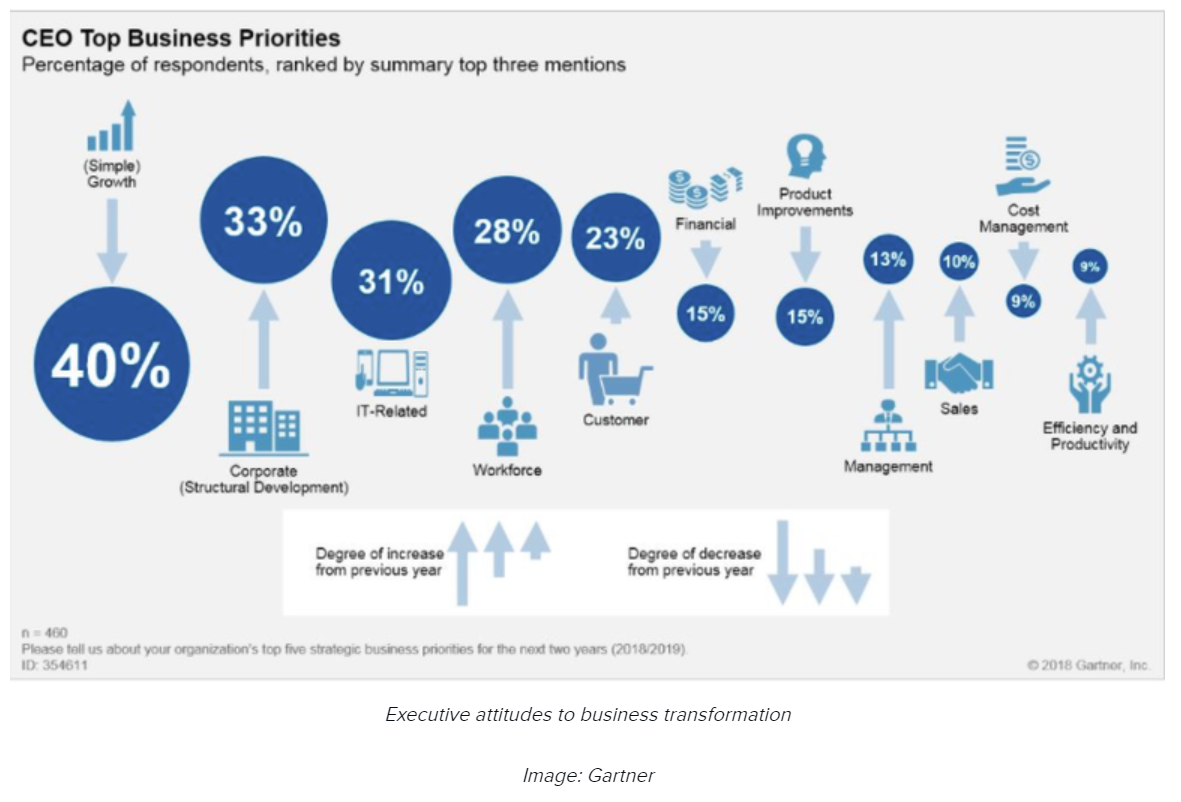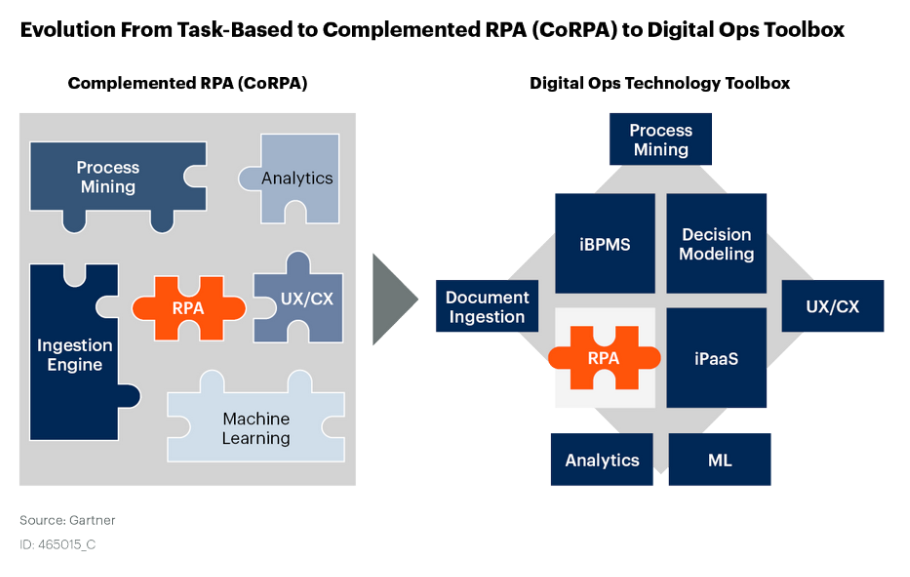Table of Contents
Table of content:
Understanding the potential of RPA and the valuable players in the Industry
Defining RPA:
Robotic process automation (also known as RPA) is a platform that helps you build, manage and run “software robots” and these software robots are used to automate business processes that are highly repeatable, and rule-based in nature.
To simplify the statement, any job that a human does today on a computer which is pretty straightforward, and does not require him to think or apply his brains with iterations, besides memorizing the steps, are perfect candidates for the jobs that can be performed by these “software robots”. This is possible because software robots have the capability of mimicking human actions on a computer system.
RPA Market
RPA is one of the most sought-after technology in the recent times and it is poised to continue its growth story.
“The global robotic process automation market size was valued at USD 1.1 billion in 2019 and is anticipated to witness a CAGR of 33.6% from 2020 to 2027.”
(source: — https://www.grandviewresearch.com/industry-analysis/robotic-process-automation-rpa-market)
Although this technology has contributed in all the major segments, but its presence in BFSI segment accounted for the largest revenue share in 2019 and is anticipated to continue its dominance.
This grandviewresearch report estimated the BFSI market size for RPA to be valued at USD 167.1 million in 2018, with an anticipated CAGR of 31.3% from 2019 to 2025. That means by 2021 the BFSI market share of USD 378.2 million will be up for grabs for the RPA players.
Now the question is who’ll get the lion’s share?
The RPA Rocketship (Growth Story)
Before we delve into who’ll be the most valuable players, let’s understand what is fueling RPA. One of the biggest driving factors for RPA adoption is the Digital Transformation initiatives being run within the enterprise.

The above study by Gartner highlights the top business transformation priorities for the executives and the decision makers. RPA in its most methodical application can influence most of these.
1. IT Related: Be it backend migration, regression testing for application migration, or day to day IT processes. RPA can find its applicability in IT Related activities
2. Workforce and “Efficiency & productivity”: with automation of processes and “Software robots” brought in to execute them, enterprise adds an army of virtual workforce. While robots take over the mundane jobs, humans become free to work on more complex, creative and challenging tasks. This optimises the cost, improves productivity and increases employee satisfaction all at one go.
3. Customer: While RPA is designed to perform the mundane work, it has the characteristics of being fast, accurate and produce correct outcomes every single time. This in turn, eliminates the errors, reduces the turn around time (TAT) and increases the throughput capacity of the processes. This greatly influences the customer experience and customer satisfaction, strong indicator for customer retention and expansion. Hence a good leading indicator for recurring revenue.
4. Financials: Apart from the factors mentioned in the points above, RPA has one of the quickest Return on Investments, since its implementation for a process can be completed in anywhere between 4 to 12weeks with scaling being as easy as deploying additional bots which takes few minutes to couple of hours. These factors can positively influence financials of the company.
While digital transformation initiatives look great on paper, its execution is a challenge in itself.This 2019 report by economictimes shows that only 17% were successful in digitally transforming at scale. The same report identifies “The biggest barriers to digital transformation is legacy technology and system integration challenges.”
This is a clear indication that RPA is going to play a crucial role as a digital transformation tool, because it is designed to do exactly that “overcome the system integration challenges and automate legacy technology”. Think of RPA as a way of doing everything that you could have done by programming integrations ( only faster with native integrations present for a lot of enterprise applications) and also mimicking human way of doing things wherever integration is not possible programmatically.
Another indication that RPA is expanding its footprint, is the expansion of strategy around RPA. Gartner came up with a call to “hyperautomation” (#1 in their strategic technology trends) which is effectively delivering end to end automation using a combination of complementary sets of tools.
The Hyperautomation Strategy
From scientific auto discovery of the processes and its steps that are viable for automation, to documentation of these steps and conversion into automation, expanding the horizon by using Machine Learning and AI Skills (computer vision, OCR, chatbots etc), bringing in efficient ways of bringing human interaction with these software robots, and setting up accountability, understanding and scope of improvements in automation programs by using integrated Advanced Analytics. Everything needs to come together to deliver hyperautomation in its true sense.

Since RPA can automate the steps that human takes on a screen, and work on the processes, it can act as a strong delivery mechanism for other technologies to achieve tangible business outcomes.
Take an example of Machine Learning Model made for “Fraud Detection”, while the model works well, it only becomes relevant to business as part of a process, steps are taken if a fraud has been detected like flagging the user to a Fraud Detection Team, putting the case submitted to hold and replying to the sender with an acknowledgment mail.
Robots can do all these steps and can use the output from the fraud detection model to take a different set of actions for the case.
Analytics is another set of business essential tool kit that can benefit from RPA. Since RPA has the granular control over the processes that it works on, it can record all the information that will be relevant for analysis of the processes and producing business specific metrics.
If we take an example of invoice processing, the bot can log the exact amount of the invoice, taxation, No of items purchased from each vendor, date of processing and date of submission, vendor name, etc.
This can help you understand the total purchase that happened for a department in a time frame, growth in spending, vendor preference when choosing certain items, payment cycle, etc. all as part of the automation and without spending additional efforts in mining such information.
The BFSI Landscape
The scope of RPA has always been the low hanging fruits for BFSI sector where the processes are well defined and streamlined.
Loan Processing, Daily Operations, Risk/Compliance Management and customer service are few of the many areas within its reach.
Ease of use of ML/AI skills within RPA -and custom solutions like Document Understanding and Screen Understanding booming in past couple of years- opens up additional set of possibilities.
Like stated previously a market share of close to $400million is up for grabs in BFSI this year alone. The actions on the following points will establish who will be the most valuable RPA platform:
1. Delivering innovative custom solutions to the enterprise will be highest priority. No matter how advanced the RPA tool sounds, only the company willing to hand hold the clients to their success and objectives will win. Remember using the product to the full potential is an onus that is with the product.
2. Do the heavy lifting. Go Cloud, let clients worry only about the automation and not about licensing, infrastructure and its scaling etc.
3. Providing Ease of Use with the platform’s capabilities is as essential as building one.
4. Open platform that is ready to integrate with other products and allows other products to integrate with them is critical. Platform’s job is to deliver automation, and being open to integrations with existing state of the art products (for e.g. Product X for Business Analytics and Product Y for ML/AI and Product Z for chatbots) aids enterprise to absorb the product in their existing setup or choose one for their purpose if native offerings are not enough.
5. Coach stakeholders about RPA. Build “Automation first mindset”. Necessary to generate the ideas that is opaque to working habits
6. Ability to scale quickly and ability to adapt to changes in environments or processes.
7. Price points for product offerings. Be Reasonable, incur the cost of changing consumer behaviour, Let the value be established first.
8. Show value of RPA beyond cost impact, show the value in terms of “what was not possible before” for example the granular eye or the click level details on the processes for Business Intelligence. Customer experience, productivity, quality, extension of automated risk and compliance checks etc.
Closing Remarks
RPA is building a way of creating, running and managing an army of virtual workforce, building a way of listening to them, to helping them when they need and identifying the avenues of work for them needs to be established by the RPA players. This is the right way forward, and the disruption due to COVID stresses on the need of humans to be able to work on critical, creative and complex works and let the bots take over on what has already been established as a process.
